Exploring Agate Stones: Patterns and Significance
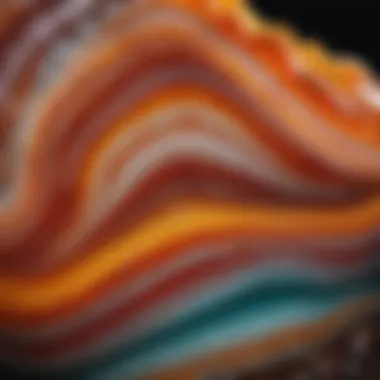
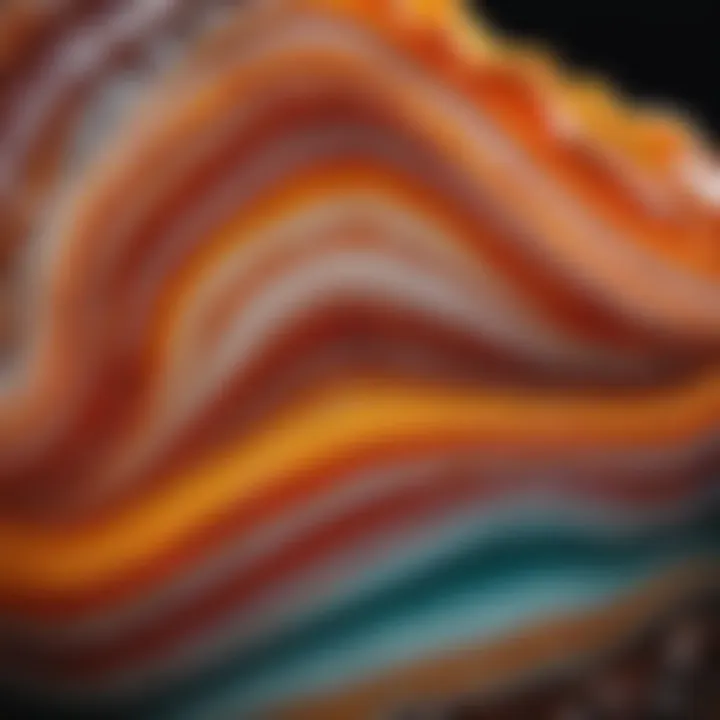
Intro
Agate stones have long fascinated both collectors and casual admirers alike. These semi-precious gems boast a rainbow of hues and unique swirling patterns that tell the geological story of their origins. More than just pretty rocks, agates serve as a reminder of Nature's artistry, having formed in volcanic and metamorphic conditions over millions of years. Rich in history, geology, and even metaphysical significance, agates are a multifaceted topic worthy of investigation.
It's not just the aesthetic value of these stones that captivates enthusiasts; it's their intricate patterns and diverse varieties that make each piece distinctive. From the gentle curves of a Botswana agate to the vibrant stripes of a Sardonyx, the visual allure pulls collectors into a world where geology and art intersect. For many, understanding agates goes beyond mere collection — it becomes a passion fueled by knowledge, respect, and appreciation.
In this exploration, we aim to uncover the myriad aspects of agate stones, focusing on their identification techniques, historical significance, and their place within the broader spectrum of Earth’s treasures. Whether you’re an avid collector or just dipping your toes into the vast ocean of geology, there is something here to pique your curiosity.
Featured Collectible of the Month
Overview
For this month, we turn the spotlight onto the Crazy Lace Agate. Known for its intricate, maze-like patterns and bright colors, Crazy Lace Agate originates primarily from Mexico. The vibrant swirls combined with deep reds, yellows, and whites make it visually stunning. Many believe that this stone holds protective energies, providing strength and vitality to its owner, making it a popular choice among metaphysical practitioners.
Historical Significance
Agate stones, particularly Crazy Lace, have not just adornments for eons; they've found their place in various cultures around the globe. Ancient civilizations utilized agate for carvings, beads, and talismans, believing in its protective properties and the ability to bring good luck. In the 3rd century, the Romans even crafted jewelry and seals from agate, drawn to its beauty and durability.
"The beauty of agate is not merely skin-deep; its layered history offers insight into the Earth’s past and the cultures that revered it."
As we examine the beauty of Crazy Lace Agate, we also catch a glimpse of the historical tapestry that envelops these remarkable minerals, enhancing our appreciation further.
Identification Techniques
Identifying agate stones can be an intriguing endeavor, provided one knows what to look for. Below are essential techniques for recognizing agate varieties.
Visual Characteristics
- Banding: Most agates feature distinct bands that may be thin or thick, straight or wavy. The pattern helps differentiate the type.
- Color: Agates come in a vibrant spectrum. Noticing the color distribution can indicate the stone’s origin.
- Transparency: Some agates are nearly opaque, while others may have clear areas, highlighting their variations.
- Texture: A polished surface can reveal clues; examining the feel and finish can also aid identification.
Resources for Identification
When it comes to recognizing your agate stones, several resources prove invaluable:
- Books: Illustrated guides like "National Audubon Society Field Guide to Rocks and Minerals" offer in-depth insights on agate varieties.
- Online Forums: Engaging with communities on platforms like reddit.com can provide firsthand accounts and experiences from fellow collectors.
- Identification Apps: Mobile apps now allow you to photograph stones and compare them against a database of known types, making identification much easier than in years past.
In summary, navigating the world of agates opens up several avenues for exploration and appreciation. As we peel back the layers of these stones, not only do we enhance our understanding, but we also cultivate a deeper connection to the geological wonders beneath our feet.
Prologue to Agate Stones
The exploration of agate stones opens a doorway into a fascinating intersection of geology and artistry. As unique mineral formations, agates offer not only aesthetic beauty but also serve as a testament to the natural processes that shape our planet. By diving into the intricacies of these stones, we unveil their significance in historical, cultural, and even metaphysical contexts.
Collectors and enthusiasts often find a deep connection with agate due to its myriad forms and colors. Every piece tells a story of formation over eons, formed by volcanic activity or sedimentary processes. This article seeks to illuminate the diverse aspects of agate stones, highlighting their critical functions in the fields of mineralogy and beyond.
The understanding of agate stones each come with its own distinct patterns and hues, gifts from nature that reflect the earth’s history. Beyond mere aesthetics, what makes agate particularly compelling is the interplay of transparency and opacity, the smoothness of its surface, and the variegated colors that can captivate any observer.
The fascination with agate is not just skin deep. Collectors need to appreciate the geological processes that birthed these stunning formations. From the layers and bands that tell tales of molten lava eruptions to the rich mineral contents that contribute to its spectrum, agate stones encourage us to engage with the ground beneath our feet in a way that words alone cannot convey. Understanding the origins and characteristics of agate gives collectors the tools to admire, assess, and care for their specimens.
Definition and Origin
Agate, a variety of chalcedony, falls under the quartz mineral family. These stones are recognized by their distinctive banded or layered structure. They form in cavities of volcanic rocks or in sedimentary layers as mineral-rich waters percolate through. When the silica in these waters crystallizes, it forms beautiful layers over time, leading to the unique patterns so sought after by collectors.
Originally, the term "agate" comes from the Achates River in Sicily, where these stones were first documented in ancient writings. Studying their origin helps enthusiasts connect with them on a more profound level, emphasizing their historical significance alongside their aesthetic appeal.
Historical Context
Agate has been appreciated across different cultures for millennia, even mentioned in ancient texts. It’s no surprise that civilizations like the Egyptians and Greeks valued it highly, bestowing it with attributes ranging from protection in battle to enhancing communication.
In ancient Egypt, agate was often used in jewelry and amulets for its perceived protective properties. Similarly, Greek mythology revered agate as a stone that could bring good luck and ward off negativity.
Through trade routes, agate found its way into many cultures, becoming a significant component of tribal ornaments in Africa, decorative items in Asia, and cherished keepsakes in Europe. Continued interest in agate remains evident today, as enthusiasts seek to collect and study these pieces of natural art. Visual representations of agate capture its beauty, but the stories behind each piece unfold in fascinating historical narratives, enriching the experience for every collector.
"The beauty of agate goes beyond mere visuals; it's the story that each stone carries through time that captivates and enriches its value."
In essence, without understanding the definition and historical journey of agate stones, one might miss the deeper connections that bind these natural formations to humanity's shared heritage.
Visual Characteristics of Agate
Agate stones are truly a feast for the eyes. Their stunning visual characteristics not only make them sought after by collectors but also invite a deeper exploration into their formation and uniqueness. Understanding these visual aspects allows enthusiasts to appreciate agate beyond just its appearance. This section unveils the various elements that contribute to its captivating beauty, wrapping together color, patterns, clarity, and texture into a cohesive understanding that can enhance both collection practices and aesthetic appreciation.


Color Spectrum
One of the standout features of agate is its vibrant color range. Depending on the geological conditions and mineral content during formation, agate can exhibit a spectrum that spans the rainbow. The presence of iron, manganese, and other minerals during the slow crystallization process can lead to hues of blue, red, yellow, green, and everything in between.
- Diverse Colors: Each color brings its own significance. For instance, blue agate is often associated with tranquility, while red agate is thought to encompass strength and vitality.
- Lateral Stripes: Many agates display layered colors, characterized by translucent bands that create depth and intrigue. The interplay of light on these layers can be quite mesmerizing.
- Role of Irradiation: Some colors, especially those with deep saturation, can be enhanced by irradiation, affecting their market value and desirability among collectors.
In effect, each piece of agate is like a little canvas painted by nature, so it's important to consider the origins behind these colors when assessing a stone's value.
Pattern Variations
The patterns found in agate are diverse and intriguing, often resembling abstract paintings. This section goes deeper into how these variations form, making every agate a unique piece of art soft to the touch but rich in complexity.
- Banding: The most recognizable feature is the banding, which can vary from very fine to extremely wide. The width and distribution of these bands can indicate the various stages of cooling and mineral precipitation. Each band tells a story of its geological past.
- Dendritic Patterns: Some agates may display tree-like structures known as dendrites, formed by mineral infiltration. These can evoke a sense of nature and provide a conversation starter for those examining the stone.
- Crazy Lace: Another noteworthy pattern is crazy lace agate. Its intricate looping patterns create a sense of movement, making it a favorable choice for jewelry.
Just like fingerprints, no two agates are alike. The appreciation for these patterns helps boost a collector's understanding of the mineral’s journey through time.
Clarity and Texture
When it comes to agate, clarity and texture play vital roles in its overall aesthetic appeal and classification.
- Transparency Variations: Agate can range from completely opaque to nearly transparent, which directly influences its value. Higher transparency often indicates a more sought-after piece, as light plays off its internal structures, enhancing its visual depth.
- Surface Texture: The texture of agate can range from smooth to rugged, depending on the cutting and polishing process. Polished agate tends to highlight its colors and patterns beautifully, while rough pieces preserve their natural features, appealing to collectors looking for authenticity.
- Identifying Quality: When inspecting an agate for purchase or collection, it is essential to assess the clarity and texture carefully. Look for inclusions or irregularities that may add character or, conversely, diminish value.
Understanding the aspects of clarity and texture can significantly enhance the appreciation of agate’s beauty, enabling collectors to make informed choices.
“The beauty of agate lies not just in its appearance, but in the story each stone carries from the deep Earth to our hands.”
By unraveling the visual characteristics of agate, one can connect more intimately with these stones while also recognizing their significance in our geological narrative.
Types of Agate Stones
Understanding the different types of agate stones serves as a key aspect of this article. Each type has its own distinct characteristics, which can influence not only their aesthetic appeal but also their geological significance. Collectors and enthusiasts alike need to appreciate these nuances to make informed decisions in their collecting pursuits.
Banding and Layering
One of the most striking features of agate stones is their banding and layering. This phenomenon occurs due to the way silica deposits accumulate, creating distinct layers of color and texture. Each band can range from a thin line to several millimeters thick, often consisting of different hues that swirl together like a painting in a gallery. These layers are formed through volcanic activity, where gases and liquids interact under heat and pressure, leading to the gradual crystallization of silica.
Collectors find layering particularly valuable. It provides a clue to the history of the stone and tells a story of its formation over millennia. Many enthusiasts enjoy seeking out those with exceptional banding patterns; such stones become conversation starters and focal pieces in collections.
Thunder Egg Agate
Unlike more traditional forms of agate, thunder egg agate has a unique origin story. Found predominantly in volcanic regions, it features a nodule structure resulting from lava cooling over time. When sliced open, these eggs reveal stunning interiors with intricate patterns that often resemble landscapes—clouds, mountains, or even abstract art. They captivate collectors who appreciate their individuality.
Thunder eggs are not merely sought after for their visuals; they are also thought to carry specific metaphysical properties. Many believe they can enhance creativity and facilitate emotional healing by creating a space for self-reflection. Thus, not only do they hold geological intrigue, but they also appeal to those drawn to the metaphysical world.
Plume Agate
Plume agate is another fascinating variant, noted for its delicate, plume-like formations. Often found in soft earthy tones, this variety displays soft, feathery patterns that arise from minerals like iron or manganese within the agate matrix. Some pieces exhibit deep contrasts in color, making them stand out dramatically.
This type has stirred the imagination of many. Observers have often compared plume agate to landscapes, where the plumes could resemble trees or smoke rising in the air. Collectors particularly relish finding stones that showcase intricate plumes, as they carry both beauty and a story of metamorphic wonders.
Moss Agate
Moving on to moss agate, this type isn't technically an agate in the purest sense, but its allure is undeniable. Characterized by its moss-like inclusions, it’s often green and features shapes reminiscent of foliage or underwater scenes. These stones often evoke a deep connection to nature, drawing in those who seek grounding through their collections.
Moss agate is sometimes associated with fertility and abundance, adding a layer of significance for those who believe in its metaphysical properties. As such, it's become a favorite among collectors who gravitate towards stones with deeper meanings or personal significance.
Fire Agate
Finally, there's the stunning fire agate. What sets this variety apart is its iridescence, which can appear in fiery shades of red, orange, and yellow. Found predominantly in areas of volcanic activity, fire agate is less about banding and more about the play of light within the stone. When light hits its surface just right, the colors seem to dance and flicker, almost reminiscent of flames.
From a collector’s standpoint, fire agate is highly sought after due to its scarcity and visual impact. It not only serves aesthetic purposes but also finds a place in various metaphysical practices, often thought to achieve a sense of vitality and passion.
Photographic Analysis of Agate Stones
The examination of agate stones through photography serves as a bridge connecting their inherent beauty to the understanding of their geological marvels. The rich colors and complex patterns found in agate make them prime subjects for photography, providing detailed insights into their structure and formation. This section explores the significance of effective photographic techniques that not only showcase agate�’s visual appeal but also reveal the stories embedded in each stone. By capturing these often hidden details, enthusiasts can better appreciate the artistry of nature that these agate stones represent.
Techniques for Capturing Agate Images
Photographing agate stones isn’t just about pressing a button; it is a careful science and art combined. Here are some techniques to consider:
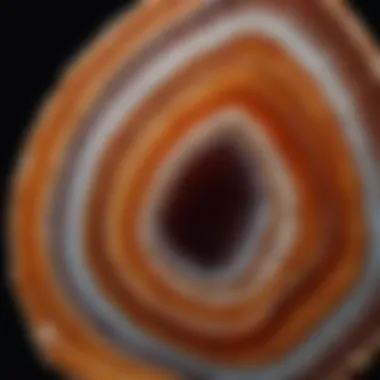
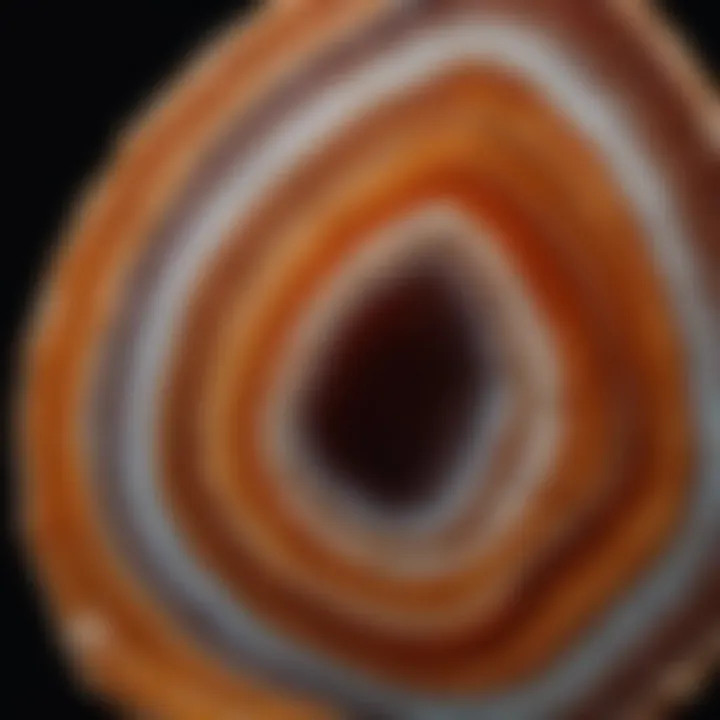
- Macro Photography: Utilizing a macro lens lets you zoom in on the delicate features of the stones. This enhances the clarity of the intricate bands and inclusions, making the images come alive.
- Manual Focus: Agate stones can be challenging to photograph due to their reflective nature and varied textures. Switching to manual focus often yields better results, allowing you to pinpoint exactly what you want in sharp detail.
- Tripod Use: Stability is key in photography. A tripod prevents blurriness and supports longer exposure times, essential for capturing the textures and colors accurately, especially under lower light conditions.
- Experiment with Angles: Different angles can highlight various aspects of the stone's structure. Rotating the agate slightly can create dramatic contrasts and unique perspectives.
- Background Choices: The background can drastically change the appearance of agate. A neutral or muted backdrop allows the stone's color and patterns to stand out, while a textured surface might add depth to the photograph.
Layering and Lighting Effects
Lighting plays a crucial role in the photographic representation of agate stones. Using different layering strategies and light sources can enhance the visual effect, providing an almost three-dimensional look.
- Natural Light: Shooting in natural light can produce soft, diffused images. Morning or early evening light tends to produce warmer tones that complement the rich colors of agate.
- Backlighting: This technique involves placing the light source behind the agate stone. The translucence of agate will allow colors to glow, revealing the inner details that might otherwise remain unnoticed.
- Reflectors: Using reflectors can help bounce light onto your subject, balancing shadows and highlighting the stone's features without harsh contrasts. A simple piece of white cardboard can achieve great effects.
- Layered Lighting: Employing multiple light sources from different angles can create depth. For instance, one light can highlight the top surface while another adds dimension to the sides.
Regular practice with these techniques will enable collectors and photographers to realize the full potential of agate's beauty through their images. Capturing these stones visually preserves their unique stories, encouraging a greater appreciation among viewers and fellow enthusiasts.
Geological Formation of Agate
The geological formation of agate is a fundamental aspect of understanding these beautiful stones. It’s not just about the end result, the colorful and patterned stone; it’s also about the intricate processes that lead to its creation. Knowing how agates are formed opens a window into the natural world, revealing the dynamic interplay between minerals, water, and volcanic activity. This knowledge is invaluable for rock and fossil collectors who want to appreciate these stones beyond their surface beauty.
Formation Processes
Agate typically forms in volcanic or sedimentary rocks. The formation processes can be broken down into several key stages:
- Silica-rich solutions: Agate begins as a solution of silica in groundwater. As water seeps through gas bubbles in the host rock, it leads to the deposition of silica.
- Layering: Over time, these depositing layers build up. Each layer can differ in color and texture due to varying mineral content, creating the characteristic banding seen in many agates.
- Cooling and crystallization: The cooling of the silica-rich solutions contributes to the development of the stone. As the solutions evaporate, quartz crystals can form within the layers, resulting in the variety of textures found in agate.
- Environmental factors: Various local environmental factors, like temperature and pressure, greatly influence the properties of agate. Depending on these factors, the patterns and colors can be strikingly different even from agate found nearby.
"The unique qualities of each agate reflect its journey through geological history, revealing the secrets of its environment."
These formation processes emphasize how patience is needed in nature. The slow creation of agate teaches us about resilience and the artful manner in which the earth operates. Each piece is essentially a time capsule, preserving a moment from the planet's evolutionary saga.
Common Locations of Occurrence
Understanding where agate can be found adds another layer to a collector’s knowledge. Agate deposits are spread across various locations worldwide, often where volcanic activity has occurred. Here are some of the key places to explore:
- Brazil: Known for its stunning color variety, Brazilian agates often boast intense hues and intricate banding.
- Uruguay: This country produces high-quality agates with vivid colors and sharp contrasts, making them quite desirable.
- United States: Areas such as the Pacific Northwest and the Arizona region are renowned for their rich deposits of agate. Notable types, like the Fire Agate and the Lace Agate, come from these places.
- India: The rich mining history in India has produced various forms of agate, characterized by unique patterns thanks to local mineral diversity.
Collectors should consider the geographical context when examining agate. Each location imparts distinctive characteristics, making every find a unique treasure. Knowing the origins can significantly enhance the connection one feels with each piece of agate.
The Metaphysical Significance of Agate
Agate, beyond its stunning visual appeal, holds a revered place in metaphysical circles. For many, these stones are seen as more than geological formations; they're considered vessels of spiritual energy with the power to heal, protect, and inspire. This section delves deep into the significance of agate stones that have captivated individuals across cultures and epochs. Understanding these facets not only enhances appreciation for agate but also enriches its intrinsic value as a gem.
Healing Properties
The healing properties of agate have been extensively documented in various holistic practices and new age philosophies. Believers argue that agate can bring about a balanced emotional state, imbue inner peace, and stimulate the body's natural healing processes. Notably, agate is often thought to be beneficial for the digestive system, encouraging a calm and regulated intake.
Some key healing benefits include:
- Emotional Balance: Agate is said to temper negative emotions and reduce stress. Its calming energy helps individuals reconnect and ground themselves, moving through life with a clearer mind.
- Physical Healing: Many holistic practitioners utilize agate to mitigate physical ailments. This can range from treating headaches to improving skin conditions. Some users report that wearing agate has led to palpable improvements in their overall well-being.
- Enhancement of Intuition: Often recommended during meditation, agate is believed to sharpen one's intuition and personal insight, aiding in making sound decisions or plans.
Ultimately, the purported benefits of agate are as diverse as its colors and patterns, making it a uniquely appealing stone for those exploring their own healing journeys.
Cultural Beliefs and Uses
Across different cultures, agate has been steeped in tradition, mystery, and symbolism. Whether in ancient tablet engravings or as offerings in spiritual rituals, the stone’s significance is wide-ranging. Its multiple layers and intricate patterns resonate with mankind’s connection to the Earth and the metaphysical.
- Ancient Practices: The Sumerians believed that wearing agate could ensure protection in battle or ward off evil spirits. Similarly, in different tribes, agate was used in ceremonial rituals, often placed on altars or worn during sacred dances.
- Symbol of Strength: In contemporary practices, agate is often used as a charm for strength and protection. Many jewelers craft pendants or bracelets with the stone to help the wearer feel secure and empowered.
- Adorning Spaces: Agate decor pieces, including coasters and bookends, not only serve an aesthetic purpose but are also believed to infuse the surrounding space with calming energy, creating a harmonious atmosphere.
In essence, the cultural significance of agate reflects its role as a guardian stone, one that links its bearer to the spiritual realm while nurturing a sense of identity and peace.
"Agate is a celebration of the Earth’s depth, embodying stories that resonate uniquely with each individual who encounters its beauty."
As we journey through the physical characteristics, types, and geological presence of agate, it becomes evident how integral this stone is—not just within mineralogy but also within the fabric of human belief and cultural heritage.
Collecting Agate Stones
Collecting agate stones is not just a hobby; it's a profound journey into the natural world's intricacies. This pursuit offers enthusiasts a chance to appreciate the beauty and history encapsulated within each stone. The allure of agate lies in its rich variety, from vibrant colors to unique patterns, making it a popular choice among collectors. Beyond aesthetics, there are several important elements to consider that enhance the experience of collecting agates.
First, understanding the geological context of agate can enrich one's appreciation. Knowing where your agates come from or how they were formed adds a layer of intrigue. Some collectors focus on specific types, while others seek diversity in their collections, grasping the vast array of colors and patterns available. Whatever the case, the thrill of the hunt—searching for that perfect specimen—can be immensely fulfilling.
Tips for New Collectors
Getting into the world of agate collecting can feel overwhelming at first, but a few strategies can make the journey smoother. Here are some handy tips:
- Research Local Mines or Collecting Sites: One of the best ways to start is by visiting local areas known for agate deposits. Often, you can find clubs or groups that organize field trips, which can be a wealth of knowledge and good company.
- Start Small: Begin with a few pieces that catch your eye rather than attempting to build a massive collection at once. This approach allows you to gradually learn about each type.
- Join Online Communities: Websites like reddit.com have communities where you can connect with other collectors, share finds, and learn about the latest trends in agate collecting.
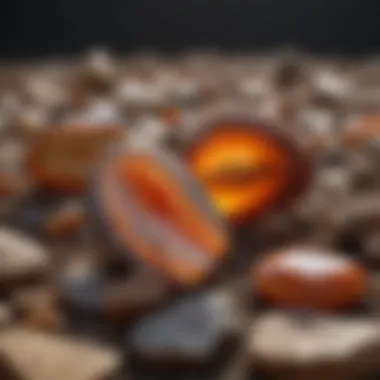

Identifying Authentic Agate
When entering the realm of agate collecting, distinguishing between genuine stones and fakes is essential. Here are several key points to help seekers identify authentic agate:
- Weight Test: Real agate is relatively heavy for its size. If a stone feels lighter than expected, it may be glass or resin.
- Pattern Consistency: Genuine agate tends to have natural patterns that can be irregular and unique. Beware of overly uniform designs that may indicate artificial treatment.
- Scratch Test: While this requires caution, agate is hard and does not scratch easily. Testing this can help verify its authenticity.
"Understanding how to spot authentic agate is crucial, not just for value but also for the integrity of your collection."
Storage and Preservation Techniques
Once you've gathered some exquisite pieces, taking care of them is paramount. Proper storage can prevent damage and maintain their visual allure. Here are some effective techniques:
- Use Acid-Free Containers: Store your agates in containers that won't cause damage, such as acid-free boxes or sleeves.
- Keep Them Dry: Avoid exposure to moisture, as this can cause deterioration. Ensure that the storage area is cool and dry.
- Regularly Check on Your Collection: Periodically inspect your stones for any signs of wear or damage.
By keeping these tips in mind, you'll not only enhance your collecting experience but also ensure that your treasures remain in pristine condition.
The Aesthetic Appeal of Agate
The aesthetic allure of agate stones is not just a frivolous fascination; it dives deeper into the realms of personal expression and nature’s artistry. Agate isn’t merely a rock; it encapsulates stories dating back millions of years, with each unique piece serving as a canvas that displays an artist's hand—Mother Nature’s hand, that is. The complex layering and vibrant hues are visually captivating, making agate a favorite among artists, artisans, and collectors alike. This section will explore how agate finds its way into art and interior spaces, serving as both inspiration and centerpiece.
Design Uses in Art and Jewelry
Agate has transcended its geological existence to become a sought-after material in art and jewelry. Artists often choose agate for its unique visual characteristics—no two pieces are exactly alike, creating a specialness that speaks to individuality and personal taste. In jewelry, the delicate bands of colors are skillfully polished to enhance their natural beauty, resulting in pieces that are not only attractive but also meaningful. From pendant necklaces to intricate rings, agate jewelry can often act as a talking point, reflecting the wearer's story or mood through color choices and design.
Here are some key points to consider when using agate in design:
- Versatility: The wide range of colors and patterns allows agate to be used in various styles, from bohemian to modern chic.
- Durability: Agate is tough, which gives it longevity as a jewelry material. It can withstand everyday wear without losing its charm.
- Symbolism: Many believe agate holds metaphysical properties, such as balance and harmony, which can add a deeper layer of meaning to the jewelry.
Whether crafted into a statement piece or used as a subtle accent, agate has the ability to shine in any artistic endeavor, making it a staple in expressive industries.
Interior Design Applications
Agate's striking colors and patterns extend beyond the realm of jewelry and art; they also find a prominent place in interior design. Homeowners and designers alike appreciate agate for its natural beauty and versatility in design applications. Here are several common uses:
- Tabletops: Agate slices, polished and framed, make stunning tabletops that not only serve a function but also become a focal point.
- Wall Art: Hanging agate pieces or wall-mounted decorations featuring agate prints can liven up any room, turning walls into canvases.
- Coasters and Accessories: Smaller cut pieces often double as coasters or decorative accents, lending an earthy touch to modern settings.
In addition to its visual appeal, agate is appreciated for its ability to complement various decor styles. Whether it's a rustic cabin or a sleek urban loft, agate fits right in, offering organic warmth amidst synthetic surroundings.
"Agate turns spaces into sanctuaries, marrying natural beauty with sophisticated design."
To wrap it all up, the aesthetic appeal of agate is multifaceted. Its designs populate the worlds of art, jewelry, and interior decoration, allowing individuals to express themselves through its natural elegance. Just as agate stones are aged and shaped by the environment, they transcend their origins to adorn our lives with beauty and meaning, thus solidifying their place in both the geological and artistic realms.
Environmental Aspects of Agate Trails
When discussing agate stones, one can't overlook the environmental aspects tied to their existence and extraction. The luster of these stones often distracts from the potential ramifications their collection can have on the earth. Understanding the intricate relationship between agate mining and the environment is key to appreciating not just the stones themselves, but also the landscapes they inhabit.
Impact of Mining on Ecosystems
Mining practices for agate stones, while rewarding for collectors, can impose significant strain on local ecosystems. From the disruption of soil layers to the alteration of water sources, the footprint of agate extraction is hard to ignore. Also, when miners dig or blow apart layers of earth, they often displace habitats crucial for numerous species.
- Erosion: The surfaces that once held flora and fauna may become barren wastelands, experiencing increased erosion due to the lack of vegetation to hold the soil.
- Pollution: Mining operations can introduce pollutants into soil and waterways. Chemicals used in extraction can seep into groundwater, compromising the health of surrounding ecosystems and the communities that rely on them.
- Biodiversity Loss: The reduction in natural habitats can also lead to a drop in local biodiversity. Species that rely on specific conditions may vanish as their environment becomes unrecognizable.
"The stunning appearance of agate stones should act as a prompt for collectors to consider the environments they come from. The beauty of these stones is matched only by the intricate ecosystems they form part of."
Acknowledging these impacts not only elevates the discourse around agate stones but also encourages more mindful practices in both collection and conservation.
Conservation Efforts
Conservation efforts are crucial in preserving the delicate balance of environments where agate stones form. They aim to mitigate the negative influences of mining while promoting sustainability. Various organizations and initiatives are stepping in to protect both agate sources and the habitats they derive from.
- Responsible Mining Initiatives: Some companies are now employing practices to minimize environmental impact. This includes reducing the area of disruption and rehabilitating sites post-mining.
- Protected Areas: By establishing protected areas, certain regions can mitigate mining activities, allowing ecosystems to thrive without the threat of exploitation.
- Community Education: Raising awareness among miners and collectors regarding sustainable practices can lead to community-led initiatives. Grassroots movements often take the charge in promoting healthier interactions with nature.
In addition to these measures, collectors themselves have a role in fostering sustainability. By sourcing stones ethically and prioritizing vendors committed to environmental practices, collectors can contribute positively to the ecosystems that yield such beautiful rocks. It’s more than just a hobby; it’s a responsibility to recognize and honor the origins of these geological wonders.
Closure
The topic of agate stones, with its intricate facets and remarkable narratives, becomes part of a broader discourse when examined in depth. In the conclusion of this article, it's vital to consider several specific elements that illuminate why agate stones hold such a significant place in geology, art, and even personal belief systems. This closing section is not merely a wrap-up; it encapsulates the essence of a rich exploration that intertwines beauty with science.
Summary of Key Insights
Amidst the multifaceted discussion of agate stones, we discover key insights that are pivotal for enthusiasts and collectors. Firstly, the visual characteristics of agate, from the saturated color spectrum to unique banding and layering, offer a visual feast that endlessly captivates. Understanding these attributes not only enhances one's appreciation but also lends valuable knowledge when it comes to making informed purchases or gathering specimens. Additionally, the cultural significance attached to agate, rooted in both historical and contemporary practices, underscores its role beyond mere aesthetics. It influences art, jewelry design, and holistic healing following the beliefs around its metaphysical properties. Finally, the environmental aspects remind us that our explorations should always mind the impact on ecosystems, leading to a balanced approach toward collecting.
Future Research Directions
As we turn our gaze to the horizon of future research, several potential avenues present themselves. One promising direction revolves around technological advancements in photographic analysis. As new techniques emerge, the opportunity arises to capture and document agate stones in ever more detailed and creative ways, enhancing our understanding of their formation and characteristics. Another area ripe for exploration lies in the effects of climate change on agate formations. With shifting geological conditions, understanding how these stones continue to evolve could offer insights into broader environmental shifts. Furthermore, the cultural practices surrounding agate in various societies present a fascinating field ripe for anthropological study. Collectors and enthusiasts should keep an eye on peer-reviewed journals and aggregator platforms for emerging studies that could further enrich their understanding and appreciation of these stones. In short, the exploration of agate stones is ongoing, and each new discovery could transform our understanding of this captivating mineral.



